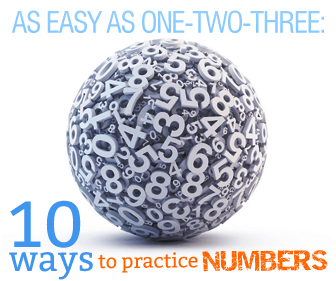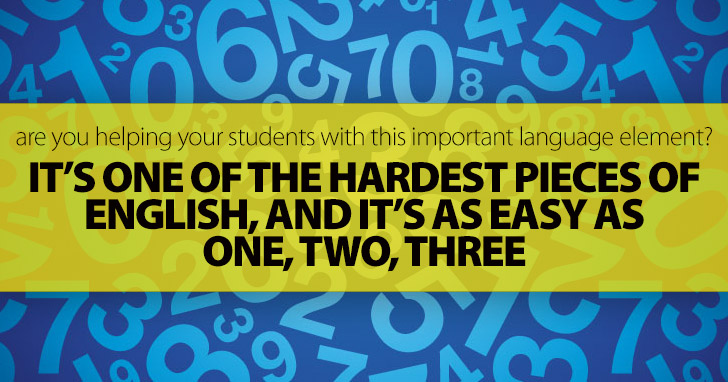As Easy as OneTwoThree: 10 Ways to Practice Numbers in the ESL Classroom


They are one of the first things children learn, and we use them every day. Why then are they so difficult for ESL students to master? Perhaps using numbers correctly and fluently is a struggle because by nature, people always revert to their first language when it comes to numbers. Have you ever noticed your students whispering in their native language before they answer a simple question using numbers in English? Have you seen math students be able to write a problem out correctly but be unable to say what they did with those numbers or why? These are just two examples of how your students’ native language can encroach on their English fluency in the neighborhood of numbers. That’s why it’s important, no matter what level your students are at, to spend some time doing activities with numbers in English. These numeric activities don’t have to cut into your class time, either; just keep a few of these activities on hand for when you need to fill five or ten minutes at the end of class. You’ll have a quick and easy time filler for your students, and it will be one that helps them in an area that is likely a perpetual struggle.

I learned one of my favorite ESL number activities when teaching in East Asia. My students there loved playing the simple game they called “Twenty-Four”, and all you need to play is one deck of cards for every group of two to four students who will be playing. To play the game, divide the cards equally among the players. Each round, players turn four cards face up. (In a four player game, each person lays down one card. For three players, two lay one card and one lays two cards; rotate the person laying down two cards each round. For a two player game, each player lays down two cards.) Players race to come up with a mathematical formula using the numbers on the cards (jack=10, queen=11, king=13) which equals twenty-four. Players can use addition, subtraction, multiplication, and division. Once a player has an answer, he slaps the cards and then gives his equation orally. He then keeps the four cards. The player with the most cards at the end of the game wins. Your students may have no trouble coming up with their twenty-four equation, but they may not find it so easy to explain that equation in English. Why not see who’s up for the challenge? Note, this game won’t be right for every ESL class. Because there is so much math involved, it is best for students who are ages eight and up.
Have you tried this traditional card game with your students? I’ll all for modifying “Go Fish” to teach vocabulary on just about any subject, but when it comes to using numbers in English, traditional is the way to go. To start, deal each player seven cards. They then take turns asking a specific player for a number card to match a card they have in their hand. If they get a match, they put the matching two cards aside and ask for another match. If they are incorrect, their turn ends and they draw a card from the pile aka “go fish”. The game is over when all twenty-six pairs have been made. The person with the most matches wins the game.
If you are teaching beginning level students who are just learning numbers in English, this simple matching game is just right for you. Check your local resale shop for some Lego blocks, or borrow a few from your kids’ toy chest. To make a permanent set of game pieces, simply write on your Legos with a permanent marker. If you want to give them back to the kids unchanged, stick some masking tape on your blocks before writing on them. You will make a set of three blocks for each number from one to twenty (or for each of the numbers you want to teach your students). One block should have the numeral (1, 2, 3, etc.), one block should have the written number (one, two, three etc.), and one block should have that number of dots on it (like you would find on a traditional die). Take all the blocks apart and put them in a bag. Students take turns pulling one block from the bag and reading the number on that block. No matter which block they choose, students will have to say the number aloud in English. Once all the blocks have been pulled from the bag, assign each student a number. On your go, students mingle, still holding the blocks they drew, asking one another for a block with their number on it. If a student has the number his classmate asks for, he gives that person the block. Students should try to get their set of three blocks before any other student gets theirs, and they should sit down once their set is complete. If you have fewer than twelve students playing, assign each person multiple numbers. Play until everyone has found all the blocks to complete their number set.
Here is a challenging game that is extremely simple to play. Each player gets four decks of cards (face cards and tens removed but aces remaining) which they put in front of them, face down in four piles. (If it’s easier, you can have your students make their own sets of cards – each set should have four each of numbers one through nine.) At the start of the round, each player flips over the top card from each of his piles, making a number with four digits. At the same time, each player scans his opponents’ cards as well as his own to determine which number is the highest. When he finds it, he slaps that number. To get the cards, however, he must read the high number aloud as well as every other number on the table. For example, a player might say, “Five thousand three hundred twenty nine is higher than four thousand eight hundred thirty-three, …” If he reads all four numbers correctly, he gets all sixteen cards and puts them aside. If he makes a mistake on any of the numbers, he loses the turn and another player gets a chance to earn the cards. Play until all the stacks are gone or you are out of time, and the person with the most cards set aside in his pile wins the game.
Every teacher benefits from having a few time fillers on hand for those five or ten minutes of unexpected class time. And every ESL student benefits from practice using numbers in English. Why not kill two birds with one stone by keeping these number games at the ready? Your students will never lack for something to do, and they will get practice at one of the hardest and yet most straightforward elements of the English language.